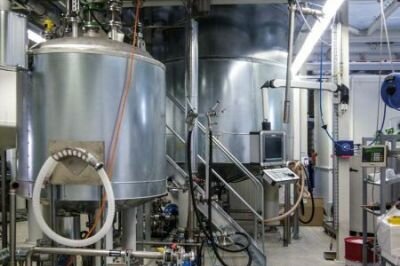Hermann Bantleon GmbH, located in Ulm, develops and produces a broad range of high-quality lubricants.
Together with VTU Engineering, a concept was developed for a new production plant for water-miscible cooling lubricants. Here, VTU was responsible for process planning as well as for the entire coordination of the instrumentation and control trades, automation and electrical planning as well as construction and building services (HVAC). During the course of preparing the concept, there turned out to be three major challenges:
- The large number of different ingredients and their different physical properties such as, for example, major viscosity differences, a great variety of different quantities to be used and dosing accuracies, as well as the addition of solid and liquid raw materials.
- The dosing and reliable addition of boric acid (as a powder). Boric acid was classified as toxic for reproduction in December 2010, which resulted in much higher requirements for handling the boric acid.
- The entire plant was to be designed as an area that is not prone to explosion, despite ingredients with a flash point around 90°C and water heating with two temperatures (70°C and 90°C).
The large number of different ingredients was addressed by a multitude of dosing and addition possibilities. For that purpose, possibilities were created to automatically add ingredients from IBC, drums as well as small packages. In addition, the possibility was created to also add minute quantities manually via weighing stations and hand hole covers. The boric acid is added by means of a pneumatic transport system and an isolator sack chute. This system ensures reliable addition and dosing in the process. It was possible to classify the entire production building as an area that is not prone to explosion. Due to an intensive safety examination by VTU, all the necessary measures for this were identified and implemented. One of these measures was securing the heating circuit of the stirrer tanks to a maximum of 70°C through the use of SIL2 inlet temperature monitoring. The basic and detailed engineering of the production plant were completed in the autumn of 2011. Three production lines are the heart of the plant. The production lines consist of one heated small and large stirrer tank each. Each line is connected to a total of six storage tanks for large-volume ingredients.
Furthermore, each line has a combined filling and suction station, as well as connections for adding ingredients by means of IBC. Ingredients with very high viscosities can be preheated in 3 heating chambers each with 4 IBC storage positions in order to improve their flowing properties. In addition, a possibility has been created with the help of a mobile dissolving tank to dissolve waxes separately at temperatures above 100°C and to add them to the stirring tanks. The products can be filled into drums or IBCs inside the plant. In addition, a connection to a stock tank farm was created. Filling into road tankers is also possible there. At the end of the process, all lines are completely emptied without any residue by means of compressed air or alternatively ultramodern pigging technology. That prevents unwanted mixing of products. Besides planning the production lines, a completely new infrastructure also had to be established. A compressed air network with generation and storage was set-up for this and a demineralised water generator with storage was installed. A hot water system was provided for heating the stirring tanks and the heating chambers. Furthermore, a high-bay storage system with space for approximately 400 pallets was built in the new three-storey building.

